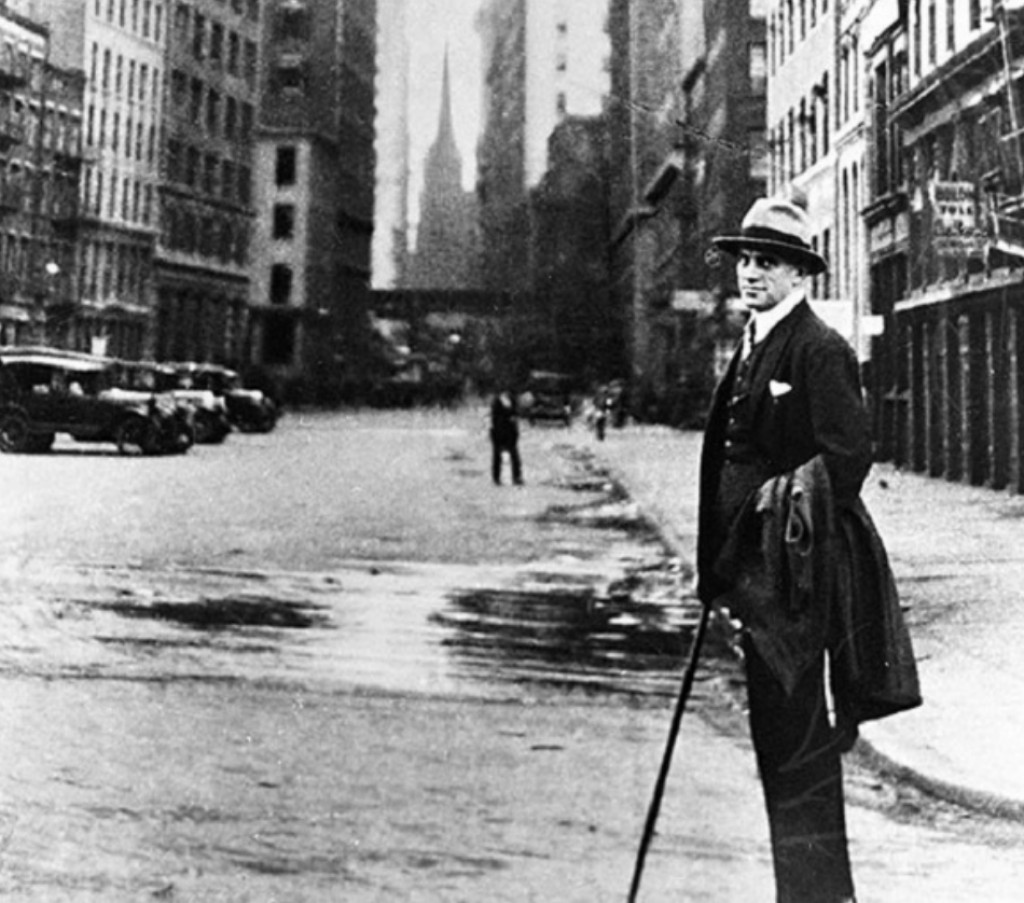The Jordan Center stands with all the people of Ukraine, Russia, and the rest of the world who oppose the Russian invasion of Ukraine. See our statement here.
Maša Kolanović is an Associate Professor in the Faculty of Social Sciences and Humanities at the University of Zagreb in Croatia.
Above: Vladimir Mayakovsky in New York City, 1925. Source
As Percy G. Adams argued in the book Travelers and Travel Liars, 1660-1800, the travelogue as a genre is known for exaggerations and distortions. It has always bordered on, and nourished, fiction. The genre’s often subjective views of "foreign" lands enable it to create and mediate insights about other countries and cultures. At the same time, the travelogue can act as a valuable literary resource, providing social knowledge about foreign countries and distant regions. This function was especially pronounced in earlier historical periods, when flows of information were not yet as developed as they are today. The knowledge travelogues offer can challenge the representations of hegemonic discourse, exposing neglected or less desirable aspects of particular geographical imaginaries. Beyond offering insight into geographical issues, travelogues can also preserve the key features of specific historical eras.
During the first half of the twentieth century, when socialism and capitalism competed for ideological dominance as narratives of modernity, the US was recorded in the visions of revolutionary socialist writers who had the opportunity to travel to America. Vladimir Mayakovsky, Egon Erwin Kisch, and Ilya Il'f and Evgeny Petrov all visited the US during that period, publishing their respective travelogues between the mid 1920s and late 1930s. Committed socialists all, these writers brought a distinctive lens to their treatments of American capitalism. Per David Harvey—a cultural geographer who often uses literary works in his analyses—space, like cartography, is a mental as well as a material construction.
Mayakovsky visited the US in 1925, motivated by a desire to witness American technological development and learn possible lessons for Soviet Russia. The Austrian and Czechoslovak writer and journalist Egon Erwin Kisch, as well as famous Soviet literary duo Il'f and Petrov, traveled to America in the subsequent decade. During this time, America was already in the throes of the Great Depression, which had devastating material and social consequences both domestically and across the world. At the same time, Nazism and fascism were gaining strength in Europe, a fact that did not go unnoticed in Kisch and Il'f and Petrov's travelogues.
By the time these three writers embarked for America, the country had already taken root in the wider global consciousness through the conceptual framework of capitalism. This was especially true in Soviet socialism, so that the great economic crisis, to which the authors refer in their travelogues, became a decisive argument in their criticism of the capitalist system and helped them emphasize the advantages of socialism.
All three travelogues thus bring a specific "communist eye" to their observations of American social, political, and economic structures, advocating for the poor and the oppressed workers of early twentieth-century capitalist industry. For instance, Mayakovsky's description of Henry Ford's famous car factory frames Fordism as a modern way of organizing work, but with an irony that exposes the flip-side of its remarkable efficiency. Beyond reporting on all the technological and organizational advancements of work in the Ford factory—aspects that featured heavily in the pro-Ford propaganda accompanying the official tour—Mayakovsky brings in additional facts and testimonies about the exploitation of laborers, poor working conditions, and workers' exhaustion.
In his foreword to the 2005 English edition of Mayakovsky's travelogue, novelist Colum McCann emphasizes the Soviet author's empathetic perspective, which is especially evident when he describes the position of immigrant workers and African Americans. A similar irony, along with empathy for the dehumanized workers of the factory line, marks Il'f and Petrov's observations of the Ford car factory in Detroit, which stress the multi-racial and multi-ethnic composition of the worker population: "the men who work for Ford are Mexicans, Poles, Czechs, Italians, Blacks," they write. Kisch, too, remains sensitive to the plight of migrant workers during the Great Depression, making special note of the inhuman working conditions afflicting immigrants and African Americans—for instance, the Syrian immigrant workers he sees toiling in a toxic environment in a Danbury, Connecticut hat factory.
In addition to depicting the wretched American working class of the 1920s and 1930s— disproportionately comprised of immigrants and people of color—the three travelogues feature detailed descriptions of poverty as such. This is especially true of Kisch's text, which describes daily life in the US at the start of the Great Depression, when mass unemployment disrupted everyday life. Kisch's travelogue pays special attention to the position of workers, listing physical injuries among laborers at large corporations; describing the meager insurance policies to which they're entitled; and detailing the exploitation of women. But in all three travelogues, the issue of race stands out as the most visible proof of the injustice inherent in the capitalist system, representing the culmination of the socialist critique of economic inequality in America.
This presentation of the vulnerability of the lower classes, shown as deeply interconnected with racial discrimination, necessarily shades into advocacy for socialism as a viable political alternative. Kisch, for the example, writes that only the communists took care of Black workers in the US. Kisch's and Il'f and Petrov's moral critiques of US capitalism invoke socialism as a progressive solution to US economic, class, and racial problems. At the same time, both travelogues note the low popularity of socialism in American political life. As Il'f and Petrov mention with trademark irony, communism is seen as "acceptable" only for those mainstream society deems inferior: "As for communism, that is something for 'dirty' Mexicans, Slavs, and Blacks. It is no business for Americans."
These observations on the intertwined nature of racial and class subjugation amount to early critiques of what Black Studies scholar Cedric Robinson termed "racial capitalism." Robinson argued that race and class form a "false dichotomy" because racial formations are incorporated into the logic of capital. According to scholar of English and Africana Studies Jodi Melamed, the "activist hermeneutic" of Robinson's coinage implies that capitalism "can only accumulate by producing and moving through relations of severe inequality among human groups." For capitalism to survive, Melamed writes, it must exploit and prey upon "unequal differentiation of human value."
The specific historical circumstances that inspired Mayakovsky, Kisch, and Il'f and Petrov's travelogues may be a thing of the past; yet socialist critique of racial and class oppression is worth reconsidering amid the precarious social and economic conditions that obtain across the globe today.



